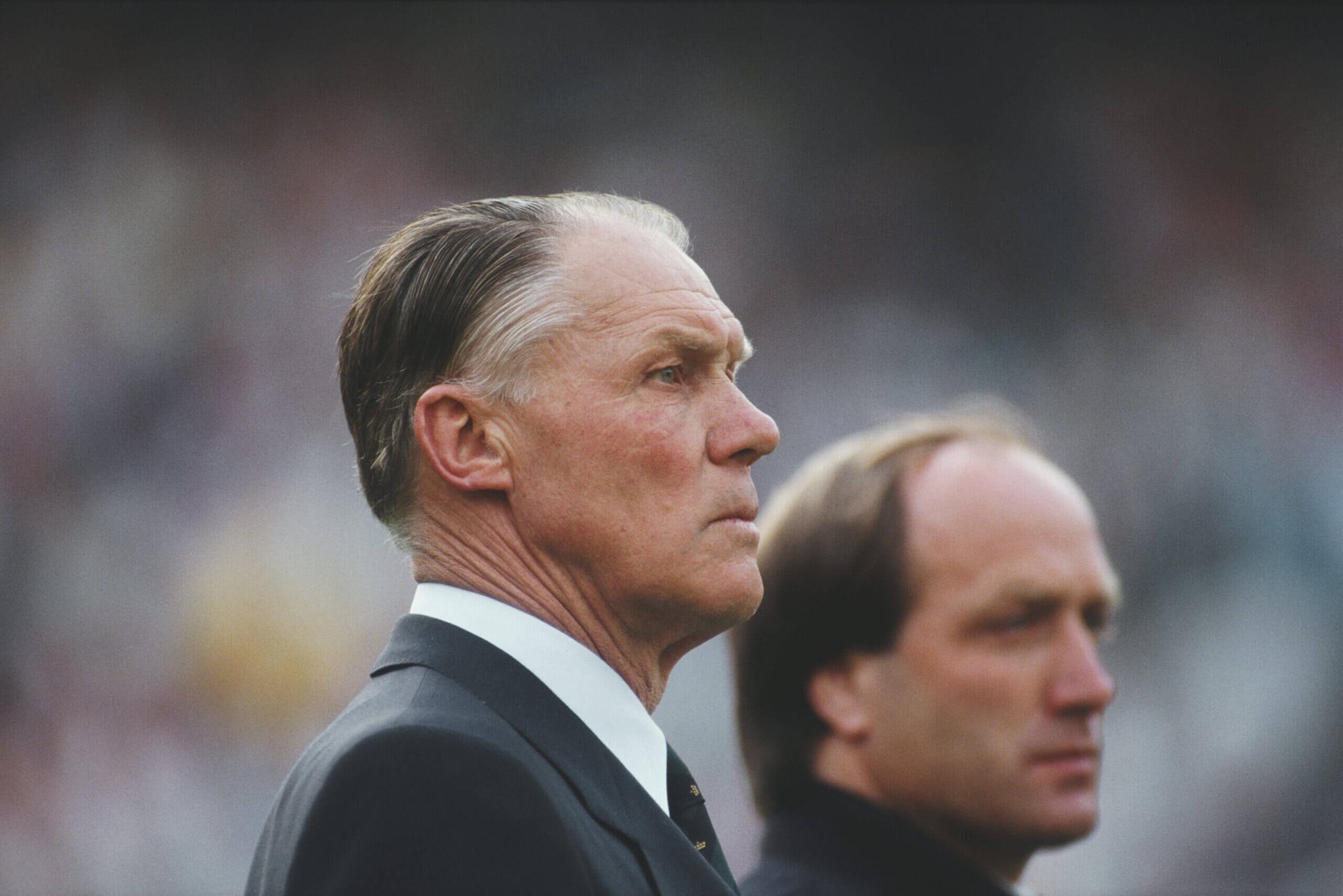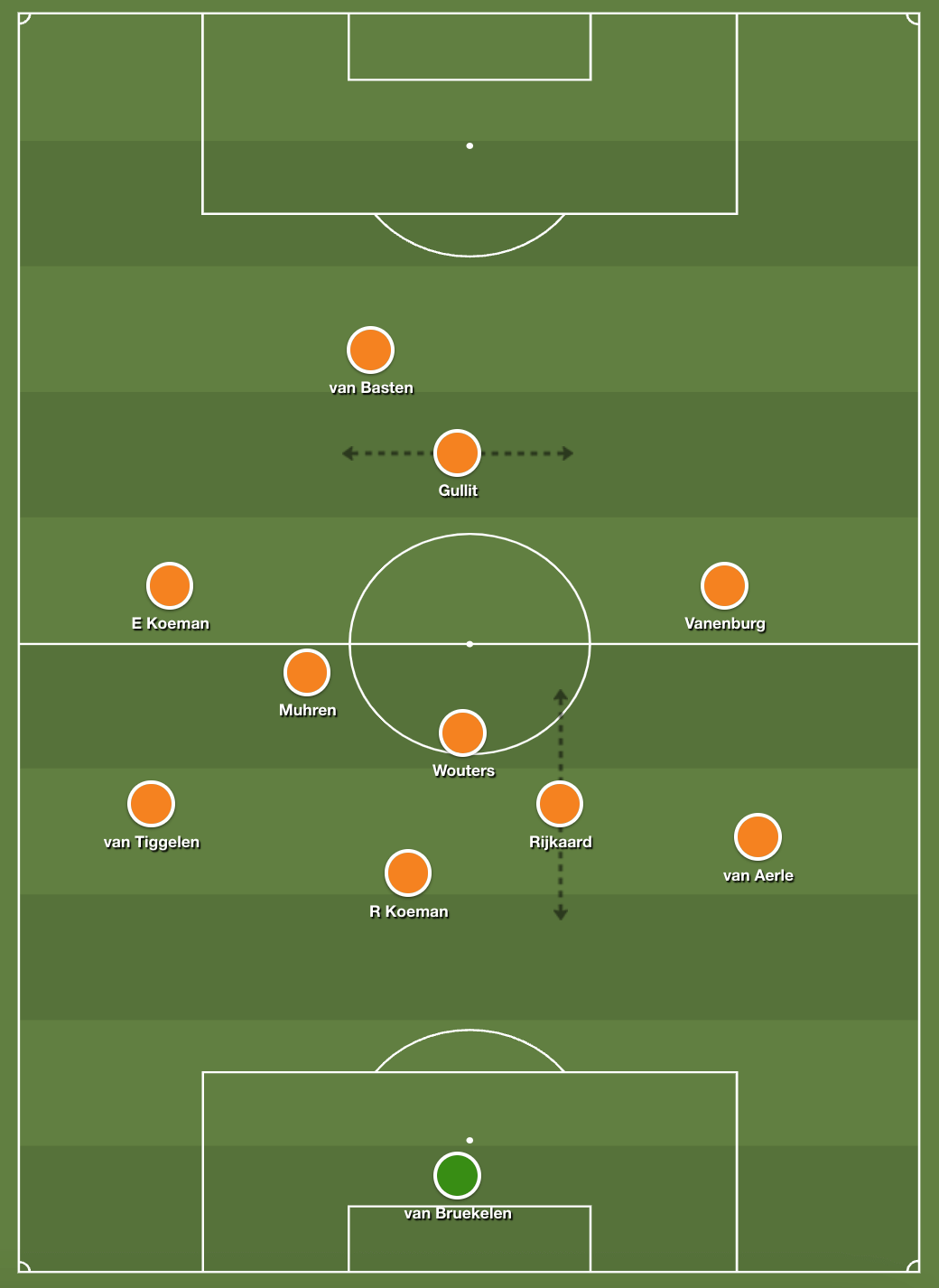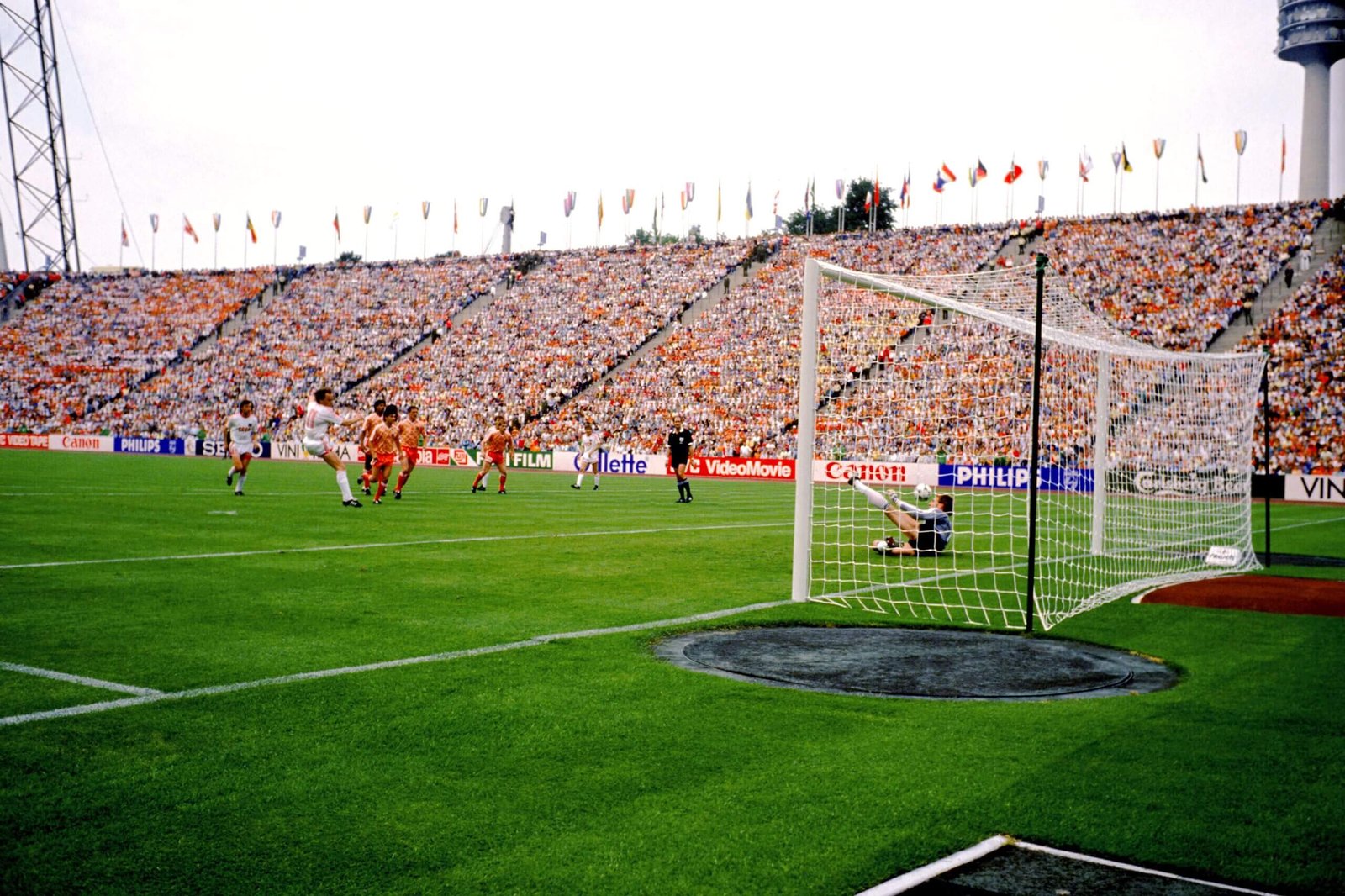This is the latest in our fortnightly series about the 16 triumphant teams in the European Championship, before the 17th edition is played in Germany this summer.
So far, we’ve looked at the Soviet Union in 1960, Spain in 1964, Italy in 1968, West Germany in 1972, Czechoslovakia in 1976, West Germany again in 1980 and France in 1984. Now, it’s the turn of the Netherlands in 1988.
Introduction
The Dutch footballing culture is probably the most fascinating in Europe.
Despite being a relatively small country which didn’t embrace professional football until the 1960s, the Netherlands have constantly punched above their weight and exerted huge influence upon footballing style across the continent. Even so, 1988 remains their only men’s tournament success.
The national side has had dramatic waves of good and bad. The Netherlands qualified for the World Cups in 1934 and 1938, then either did not enter or fell short of the next six; they reached successive finals in 1974 and 1978 then, confusingly, were absent for both the World Cups in the 1980s. During that latter era, the previous generation were too old, and the next generation were too young — although they had come of age by 1988.
None of the Dutch squad had played in a major tournament until they made the short journey over the border to West Germany for Euro 88.
They were, incidentally, almost exclusively referred to as ‘Holland’ at this time, both by English language media and by the Dutch players themselves.
Marco van Basten celebrates scoring his second goal against England (Peter Robinson – PA Images via Getty Images)
The manager
Rinus Michels — arguably the most renowned coach in football history. He was named Coach of the Century by FIFA and then, in 2019, the greatest coach in the history of football by France Football.
Those honours were largely because of his invention of Total Football as Ajax coach in the early 1970s. Michels subsequently took that same approach to Barcelona alongside Johan Cruyff, and then to the national side for their glorious near-miss at World Cup 1974. After that, he had a second stint with Ajax, another spell with Barca and worked in West Germany and the USA.
He became Netherlands coach again in 1984, stood down after suffering from heart problems, but was reappointed two years later.

For all the excitement associated with Total Football, which was all about space, pressing, maintaining width and switching positions, Michels was also an old-school coach and a tough taskmaster. He drilled his players relentlessly in training and was nicknamed The General.
World Soccer magazine was particularly complimentary about him after these Euros, describing him as “head and shoulders above every other manager at the tournament, as a strategist, physiologist and human being.”
Tactics
While regarded as the godfather of Total Football, Michels’ Dutch team of 1988 was rather different to his 1974 World Cup one, less based around rotations.
The attacking flair and movement generally came from Ruud Gullit, the second striker, who drifted towards the flanks to provide passing options. There was much debate about the role of Marco van Basten, who tended to come short to link play, but was at his best when staying on the last line and focusing on goalscoring. Michels said that the major tactical concept his players had worked on during training sessions was passing in behind.
In midfield, Jan Wouters was the classic holding player. Erwin Koeman and Arnold Muhren offered more guile, while the right-sided Gerald Vanenburg was a tricky winger.

The most interesting aspect of the side was at the back, where Michels fielded a highly technical centre-back partnership of the outstanding Frank Rijkaard, who always pushed forward into midfield when they had the ball, and Ronald Koeman, most renowned for his long diagonal passes and powerful shots. No one else in Europe was fielding a centre-back duo so technically gifted and it’s worth pointing out that several sides, including their eventual Euro 88 semi-final opponents West Germany, were still playing tough man-markers with a sweeper.
There is a certain irony, though, that the Germans’ manager was Franz Beckenbauer, whose forward-thinking play from defence had shown the way for ball-playing defenders such as Rijkaard. Dutch right-back Berry van Aerle was also a converted midfielder, although less creative than the centre-backs. “In football, there are workers and there are thinkers,” he said. “I’m a worker.”

(Rzepka/ullstein bild via Getty Images)
Key player
Coming into the tournament, the hype was mainly about Gullit, the captain and Ballon d’Or holder who was described as “Europe’s single most outstanding individual of the last decade” by Argentina’s 1978 World Cup-winning coach Cesar Luis Menotti, who marvelled at his ability to play in defence, midfield and attack with equal ability.
But Gullit, exhausted after his first season in Italy with AC Milan after a move from PSV Eindhoven, struggled to demonstrate his best form in this competition, particularly given the expectation that he would be the equivalent of what Cruyff was in 1974. That was never going to be possible. “The development of a team is so perfect now that it is difficult for a player to have a starring role, as in 1974,” explained Michels.
That meant the outstanding individual was Van Basten, and not merely for his contribution to the final (more on that later).
In the group stage, he scored a famous hat-trick in a 3-1 win over England. The first came after he received an outside-of-the-foot ball from Gullit, spun Tony Adams brilliantly and fired home. The second was another left-footed finish from another classy assist from Gullit, and the third a right-footed volley at a corner.
In the semi-final, he scored a winner against West Germany that was both scruffy and absolutely genius, running onto a Wouters through-ball and surprising the German defence by converting an effort that was partly a slide tackle, and partly a shot. And then, of course, came the final — when he would make it five goals in four starts.
You think of Van Basten as an experienced player at this point but he was just 23 and, like Gullit, coming off the back of a draining first season with Milan. Injuries had already been an issue and John Bosman started instead of him in the opener against the Soviet Union, which disappointed Van Basten so much that he considered going home. But he stuck around, got his chance in match two against England and put himself into the history books.

(Mark Leech/Offside/Getty Images)
Van Basten has become even more mythical because his career was effectively over at the age of 28, departing the 1993 Champions League final with a serious ankle injury after a tough tackle by Basile Boli.
Subsequent years prompted a debate about the concept of the ‘tackle from behind’, and laws became stricter. But Van Basten was able to put himself about, too, and it’s worth pointing out his fitness issues actually started when he picked up a serious injury while attempting to foul an opponent in an Eredivisie game.
The final
A 2-0 win over the Soviet Union. Not quite a damp squib, but not a great showcase of Dutch football; the goals came from a set piece (Van Basten nodding on a cross in the aftermath of a corner and his strike partner Gullit crashing home a header) and a counter-attack.
OK, it wasn’t just a counter-attack, it was one of the greatest goals of all time. But the nature of those situations summarised the fact that this was a cagey, defensive game. Holland, usually obsessed with dominating possession, let the Soviets dominate in the opening stages and then tried quick dribbles or long balls to exploit space.
The problem, really, was the Soviet side had beaten the Dutch 1-0 in both sides’ first group match. “We played well in the first half and the Soviets let us take the game to them, but then in the second half they killed us off with their counter-attacks,” said Michels of that first game. “So we came into the final knowing that this time we had to start more cautiously.”
Holland played their best football once they’d gone 2-0 up, although they were also lucky that when the Soviet Union had the chance to get back into the game from the penalty spot, Igor Belanov’s poor spot kick was kept out by the knee of Hans van Breukelen, whose penalty-saving expertise had won the European Cup final for PSV after a shootout with Benfica a month beforehand.

(Peter Robinson/EMPICS via Getty Images)
The defining moment
Traditionally, there is an elite trio of goals which come into consideration to be the best ever: Carlos Alberto’s for Brazil against Italy in the 1970 World Cup final, Diego Maradona’s second for Argentina against England in the quarter-finals at World Cup 1986, and Van Basten’s here.
They are all entirely different types of great goal: a team move, a mazy dribble, a brilliant strike.
This, therefore, is maybe the most celebrated single kick of a football ever.
The assist was a left-wing cross from Muhren, playing in his final game for his country, although he freely admits it was a poor ball. “I hit it too hard,” he later said. “If Marco had shot that ball into Cologne (the final was in Munich, five hours’ drive away), everyone would have said that he could do little with that cross. Now it was suddenly the most beautiful assist ever. Marco made it beautiful.”
The finish was perfect — absolutely leathered, with precisely the right amount of topspin to send it over goalkeeper Rinat Dasayev and into the far corner.

(Peter Robinson/EMPICS via Getty Images)
There are two interesting things about Dasayev’s contribution that confirm how unexpected the shot was.
First, as the cross came over, Dasayev was busy pointing at his defenders to mark Gullit, perhaps remembering that the Dutch opener came from another deep cross that Van Basten nodded towards his partner. Second, Dasayev was completely wrong-footed in his desperate sudden attempt to reach the shot, almost landing back-to-front and then awkwardly spinning back around again.
On the bench, Michels almost looked overcome with emotion, and would constantly reference this goal in the future, in relation to his feeling that football had become too structured and lacked moments of individual magic like this.
THIS moment = 😍🤪🤯
🇳🇱 #OTD at EURO ’88, Marco van Basten scored a famous volley in the final as the Netherlands became champions! 🏆
The best EURO goal ever? 🤔@OnsOranje | @MarcoVanBasten pic.twitter.com/OAJRAnDOCi
— UEFA EURO 2024 (@EURO2024) June 25, 2019
You might be surprised to learn…
The semi-final win over West Germany was celebrated far more keenly back home than the final victory over the Soviet Union.
“For the Netherlands, the semi-final against West Germany was the real final,” said Gullit, many years later. “Fourteen years before, the whole country had sat weeping in front of the television as they watched the Dutch suffer defeat to West Germany in the World Cup final of 1974. We had come to put that right.”
For a lot of supporters, there was extra significance, and many references to the Second World War — among the huge number of Dutch fans in Munich that day were chants of, “Give us back our bicycles”, a reference to the confiscation of bikes after the Germans’ 1940 invasion of the Netherlands.
That 2-1 victory in Hamburg was considered so important that, as Gullit said, “the championship had been won, as far as I was concerned”. The squad had a huge party afterwards, and the following day, a Wednesday, attended a Whitney Houston concert in Munich, not your traditional preparation for the Saturday final, which was considered something of an afterthought.
Something similar happened four years later, when the Dutch defeated a unified Germany in the group stage of the 1992 Euros and subsequently slipped up against underdogs Denmark in the semi-final.
The definitive book on Dutch football, David Winner’s A Brilliant Orange, mentions how, after that semi-final win over West Germany, “the sober, sensible, calm and careful Dutch went completely, utterly, entirely out of their minds with joy…nine million of them threw the biggest party the country had seen since the Liberation.”
And then? “Holland went on to beat the Soviet Union in the final in Munich, and that was nice, too.”
Were they the best team?
Maybe. They lost that opener to the Soviets and, before Van Basten’s hat-trick in the second game, England had twice hit the woodwork at 0-0. The Dutch subsequently only beat the Republic of Ireland, outsiders in the group, 1-0 in a must-win finale courtesy of a scrappy header from an offside position by substitute striker Wim Kieft, one of those awkward tall centre-forwards the Netherlands produce many of but also seem a little embarrassed by.
That said, it’s tough to make an argument for any of the other seven sides being definitively better. The Germans were tournament favourites but lost a semi-final dominated by controversial penalty decisions, while the Soviets lacked the star quality of the champions. Afterwards, Michels said the two finalists were the two sides who attempted to play “modern football”.
The Dutch are better than most nations at differentiating between quality of football and success.
This, as mentioned at the top of this article, remains their only triumph in a major men’s tournament, but their most celebrated national side remains the one from World Cup 1974.
(Top photo: Getty Images)
Read the full article here


